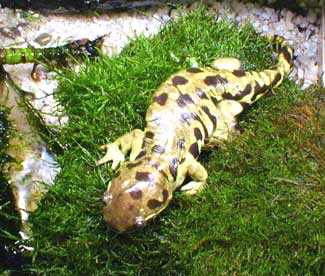
Java Moss
Vesicularia dubyana or Java Moss is shown here with my Tiger Salamander resting on it. I raised that Tiger from an aquatic larvae, & he's tame as salamanders can be. He usually lifts his head up to see if I have a worm for him when I open the top, but in this photo he tucked his head down in the protective position; I guess the camera spooked him.
Java Moss will do well permanently submerged in water. It can be let to drift loose in the water current as a big ball of moss in which fish fry can hide from their cannibal parents. When it adheres to some surface it usually changes a bit, ceasing to grow in a ball but spreading by its teency rhyzomes into a carpet less than an inch thick, eventually covering the entirety of the substrate.
I use it mostly as an out-of-water bog-terrarium moss. It is not necessarily totally aquatic, & will spread just as rich & dark over moist gravel or, most especially, over wood, just so long as it never totally dries out. When grown out of water it "blooms" with reddish brown sporocarps, but these never appear when entirely submerged, lending me to suppose it slightly prefers life out of the water, or is only seasonally completely under water in the tropical wilds.
My tanks usually have a pool at one end, & a pump that lifts water from the shallow end to spill onto the land, so that water circulates throughout the whole of the tiered gravel substrate. This circulation keeps healthful bacteria thriving in the gravel which turns waste amonia into useful nitrates for the plants. This also keeps the land portion of the mixed environment from being completely dry.
The moss is perfect for just such a frog or land-salamander environment, where it experiences moisture & high humidity, & adheres to the substrate just firmly enough that animal specimens won't just hide under it.
Native of Southeast Asia, India, Burma, Java, & the Philippines, this tropical moss is nearly impossible to fail with, even if you've had bad luck with other aquatic plants. It remains the deepest green & spreads rapidly whether in dim light or bright light. Dim to medium light is better because in bright light, various forms of algae can compete with the java moss, but in dim light the moss alone thrives. Water pH seems to be inconsequential to its health, though soft or neutral pH is likely to be preferred by plant & animals alike.
It can be instantly cultivated by ripping a piece of it loose & putting it in the next tank over. It does well in room temperature. Assuming you never let it actually freeze inside your house, it does not require a heated tank, & I've grown it exclusively in unheated tanks for salamanders which don't like to be very warm. It would, however, do just as well in a very warm tropical aquarium. It probably wouldn't do for an outdoors pond in places with chilly winters, though I never tried it to be sure. I did once "discard" some of in a moist shade garden outdoors to see if it could survive & spread, but it could not.
It will keep pollutants pretty much permanently out of tank water, so that water-changes become next-to-unecessary. It's a one-plant biofilter & every time you "weed it" back & toss the extra in the compost, you're also discarding filtered wastes that it transformed into its own plant cells. In terrarium set-ups it may get large frog poops on it or otherwise get soiled, which doesn't harm it but can be unsightly. Any that is adhering to wood or a stone can be lifted out, swished around in a bucket of water, & put back in the terrarium clean & bright. If allowed to drift loose in deep water it may accumulate particles from which it absorbs nutrients, but if it begins to look dirty, it can be taken out & swished around in a bucket & cleans up nicely.
One trick of interest for aquariums is how java moss likes to adhere to a coconut shell, as readily as it adheres to wood. Cut a coconut shell into a "cavern" shape, remove every bit of the inner coconut meat, boil the shell to leech out the tannins, then attach some small bits of java moss & place it in the aquarium. In a surprisingly short time you'll have a mossy green-domed cave for fish or amphibian larvae to use as a hide-house or den.
Yet another trick is to use java moss as a "backing" in an aquarium, as it additional likes to adhere to corkboard. Cut a thick piece of corkboard to exactly the size of the back glass so that no animal can squeeze behind it. Staple or sew a few small pieces of java moss to the board while wedging it against the back glass. The moss will soon adhere & spread over the entire wall. The cork might decompose over time, but I used long piece of mossed cork for a floating turtle-raft for ten years until it finally sank, & even then the cork was completely intact, though when I finally decided to get rid of of it, it did crumble very easily for the compost.
In or out of the water, it will eventually competely cover the substrate, & if that effect is not desired, it will demand weeding back every three or four months. It peals away easily enough, having no actual roots. Because it especially loves to adhere to wood, the only possible problem is how it can completely hide the decorative wood in any arrangement, though most of the time such a mossy-wood effect is splendid. The moss requires no fertilizing beyond whatever waste it soaks up from the critters that live with it.